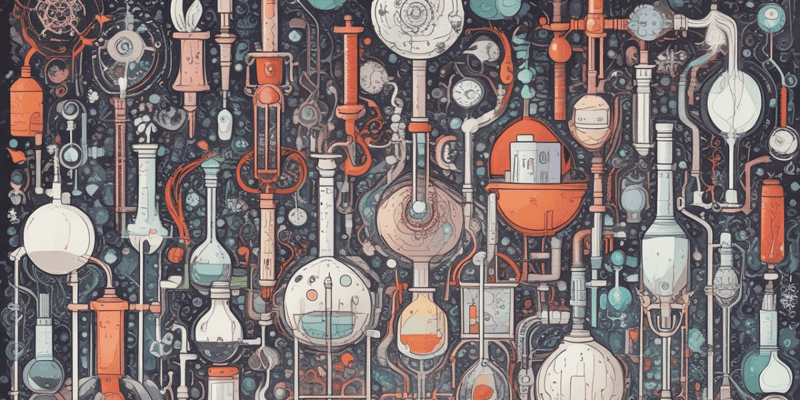25 Questions
Which of the following is true about exothermic reactions?
They tend to be spontaneous
Which of the following is true about reactions that increase entropy?
They tend to be spontaneous
What does a negative ΔG indicate?
An exergonic reaction
What does a positive ΔG indicate?
A non-spontaneous reaction
When is a reaction at equilibrium?
When there is no net transfer of heat or energy
When is a reaction considered under non-standard conditions?
All of the above
How does the Gibbs free energy change when the reactants are increased compared to the products?
It becomes more negative
How does the Gibbs free energy change when the reactants are reduced compared to the products?
It becomes more positive
What is the rationale for why the body phosphorylates ATP as a source of energy currency?
ATP can be coupled to endergonic reactions
Do enzymes themselves drop the ΔG?
No
Which one of these is the definition of a closed system?
A system that exchanges energy, but not matter with the environment outside the system
Which one of these is the definition of an open system?
A system that exchanges energy and matter with the environment outside the system
According to the first law of thermodynamics, what happens to the total amount of energy in the universe during a chemical change?
It remains constant
What does the term 'enthalpy' refer to?
All of the above
How is the change in enthalpy (ΔH) measured in a chemical reaction?
By measuring the change in heat within the system
What is the ΔH value for an exothermic reaction?
Negative
What is the ΔH value for an endothermic reaction?
Positive
What is the ΔH value for an isothermic reaction?
Zero
According to the second law of thermodynamics, what happens to the total entropy of the universe?
It increases
What does an increase in entropy (S) indicate?
The energy in the system is more dispersed
A positive ΔH can sometimes will cause a spontaneus reaction if ΔS is...
A negative ΔS can sometimes cause a spontaneous reaction if ΔH is...
A reaction will never be spontaneous if...
If the [Products] is higher than the [Reactants] the reaction is less likely to be..
A reaction will always be spontaneous if...
Study Notes
Exothermic Reactions
- Exothermic reactions release heat energy, resulting in an increase in temperature of the surroundings.
- Common examples include combustion reactions.
Entropy and Reactions
- Reactions that increase entropy (S) tend to disperse energy and matter, leading to a more disorderly system.
- Increasing entropy is associated with processes like mixing, phase changes from solid to liquid, or gas formation.
Gibbs Free Energy (ΔG)
- A negative ΔG indicates a spontaneous reaction, meaning it can occur without external input.
- A positive ΔG suggests a non-spontaneous reaction, requiring energy to proceed.
Reaction Equilibrium
- A reaction is at equilibrium when the rate of the forward reaction equals the rate of the reverse reaction, resulting in constant concentrations of reactants and products.
Non-Standard Conditions
- A reaction is considered under non-standard conditions when reactants and products are at concentrations other than 1 M, and/or when temperature is not 25°C or pressure is not 1 atm.
Gibbs Free Energy and Concentration Changes
- Increasing reactants compared to products typically lowers ΔG, favoring the formation of products.
- Reducing reactants compared to products raises ΔG, making the formation of products less favorable.
ATP Phosphorylation
- Phosphorylation of ATP occurs to store energy in high-energy phosphate bonds, serving as a key energy currency for cellular processes.
Enzyme Function
- Enzymes do not affect ΔG directly; they lower the activation energy, speeding up the rate of reaction without altering the energy change.
Thermodynamics Systems
- A closed system can exchange energy but not matter with its surroundings, ideal for studying changes without mass loss.
- An open system allows both energy and matter to be exchanged, typical in biological environments.
First Law of Thermodynamics
- The first law states energy is conserved; it cannot be created or destroyed, only transformed, during a chemical change.
Enthalpy (ΔH)
- Enthalpy refers to the total energy of a system, including internal energy and pressure-volume work.
- ΔH is measured by the heat absorbed or released under constant pressure during a reaction.
Enthalpy Change Values
- ΔH for exothermic reactions is negative, indicating heat is released.
- ΔH for endothermic reactions is positive, indicating heat is absorbed.
- Isothermal reactions have ΔH equal to zero, where temperature remains constant.
Second Law of Thermodynamics
- The second law states the total entropy of the universe tends to increase over time, leading systems toward disorder.
Spontaneity Conditions
- An increase in entropy (positive ΔS) can offset a positive ΔH, potentially allowing a spontaneous reaction.
- A negative ΔS with a positive ΔH can also lead to spontaneity under specific conditions.
- A reaction will never be spontaneous if both ΔH is positive and ΔS is negative.
- If product concentration exceeds reactant concentration, the reaction is less likely to proceed forward.
- A reaction will always be spontaneous if ΔG is negative.
Test your knowledge of thermodynamics and the definitions of open and closed systems with this quiz. Learn about the first law of thermodynamics and how it applies to chemical reactions.
Make Your Own Quizzes and Flashcards
Convert your notes into interactive study material.




